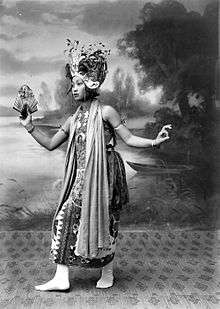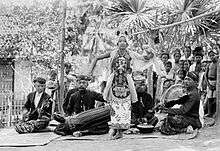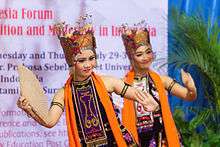Gandrung


Gandrung is a traditional dance from Indonesia. Gandrung has many variations and is popular in Bali, Lombok and East Java,[1] among the Balinese, Sasak and Javanese (especially Osing Javanese). The most popular variation is Gandrung from Banyuwangi region[2] in the eastern peninsula of Java, so much that the city is often referred as Kota Gandrung or the City of Gandrung.[3]
Originally a ritual dance dedicated to the goddess of rice and fertility, Dewi Sri, it is currently performed as a social dance of courtship and love in communal and social events, or as tourist attraction.
Descriptions
Gandrung is named from Javanese word for love.[1] It is theorized that the dance originated in ritual dance to express love of the people to the rice goddess, Dewi Sri,[4] with trance and as a kind of fertility dance.[5] However, it is currently lost its ritual connotations, especially among Muslims Javanese and Sasak. The dance evolved into social dance describing a girl looking for love companions. The dance therefore has been de-ritualized, and mostly lost its connection with the rice divinity.
Gandrung usually performed in an all-night performance that begins sometime around 9 p.m. and ends just before dawn.[2] Gandrung is also commonly played as tourist attraction,[1] for example in Bali or in Grajagan Bay in Banyuwangi. It is also performed as social dance in communal and social events such as circumcision or wedding.
The "gandrung", or the main dancer, is usually an unmarried girl or a transvestite[6] (or simply boys playing the role of female dancers).[4][6] The dancer dressed in traditional costume, with fan, shawl and wearing ornamental headgear.[5] Often there are more than one gandrung dancer in the performance.
Gandrung usually started with the dancer(s) in side of stage surrounded by gamelan ensemble. When the music started, the dancer would start the dancing movement with hip thrusting and move to the center stage. When the gandrung spots an audience member she wishes to dance with, she throws her shawl to the audience to bring him to the stage.[5] The dancer and the audience member will then dance together. If there is more than one gandrung dancer in the performance, each dancer will choose a partner and dance with their respective partners. The audience member who had danced with the gandrung usually gives a small amount of money[1] as token of appreciation. Gandrung is now also performed as dance of courtship and love, between girls and boys in central and eastern Lombok. It is usually performed outdoors by the young men and women of the village with everyone standing around in a circle.[7]
Similar dances are known throughout the Indonesian archipelago, such as ronggeng or tayuban in East and Central Java, jaipongan in West Java and Banten, and joged in Jakarta.
Music

The dance is performed to the tunes of a traditional ensemble similar with gamelan,[1][2] often composed of two violins, gendangs, bonang and gongs with gamelan xylophones (gambang). A singer is also present to sing the accompanying song for gandrung performance.[8] Villages in Banyuwangi, Bali and Lombok sometimes has their own gandrung music ensemble. Variance in ensemble composition existed between difference area where gandrung is performed [5] The music has been described as "vibrant and earthy" [2] and has been recorded by several anthropologists.
See also
References
- 1 2 3 4 5 Müller, Kal (1997). East of Bali: from Lombok to Timor. Tuttle Publishing. p. 52. ISBN 9789625931784.
- 1 2 3 4 "Music of Indonesia, Vol. 1: Songs Before Dawn: Gandrung Banyuwangi". Smithsonian Folkways Recordings.
- ↑ Herriman, Nicholas (2006). "Fear and Uncertainty: Local Perceptions of the Sorcerer and the State in an Indonesian Witch-hunt". Asian Journal of Social Science. BRILL. 34 (3): 360–387. doi:10.1163/156853106778048669.
- 1 2 Descutner, Janet; Elizabeth A. Hanley; Jacques D'Amboise (2010). Asian Dance. Infobase Publishing. p. 71. ISBN 9781604134780.
- 1 2 3 4 Harnish, David D. (2006). Bridges to the ancestors: music, myth, and cultural politics at an Indonesian festival. University of Hawaii Press. ISBN 9780824829148.
- 1 2 Hinzler, H. I. R.; Rijksuniversiteit te Leiden (1986). Catalogue of Balinese manuscripts in the Library of the University of Leiden and other collections in the Netherlands. Brill. p. 118. ISBN 9789004072367.
- ↑ Witton, Patrick; Mark Elliott; Paul Greenway; Virginia Jealous (2003). Indonesia. Lonely Planet. p. 548. ISBN 9781740591546.
- ↑ McConnachie, James (2000). World music: the rough guide, Volume 2. Rough Guides. p. 124. ISBN 9781858286365.